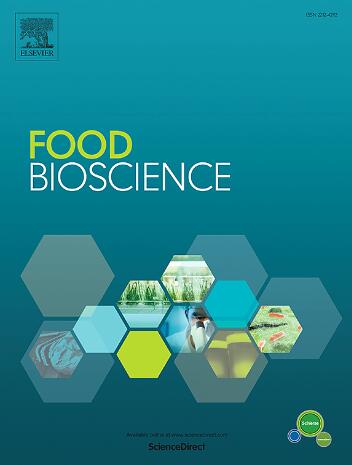紫外- b辐射对发酵杏鲍菇菌丝生物活性、酚类物质、β -葡聚糖、维生素D2及抗氧化活性的影响
IF 4.8
1区 农林科学
Q1 FOOD SCIENCE & TECHNOLOGY
引用次数: 0
摘要
本研究探讨了紫外线b (UV-B)光如何提高杏鲍菇菌丝体的营养和药用价值。将冻干的马尾松菌丝暴露在UVB光下不同时间(0 ~ 60 min), 40 min后,马尾松菌丝的维生素D2含量显著升高,达到峰值314.75 μg/g,总酚含量从12.52 mg GAE/g增加到17.54 mg GAE/g,总黄酮含量从1.19 mg QE/g增加到1.72 mg QE/g, β -葡聚糖含量从26.18%增加到32.21%,抗氧化活性显著提高。暴露在中波紫外线下也增强了氨基酸的分布,谷氨酸、精氨酸和苏氨酸等必需氨基酸的含量大幅增加。对照与uv处理后的羊角假单胞菌菌丝体代谢谱发生了显著变化。硝酸异山梨酯等关键化合物从1.56%上升到3.24%,正十六酸从19.91%上升到27.73%,十八酸从0.36%上升到1.09%。这些变化表明抗氧化和抗炎特性增强。其他化合物,如苯酚、3,5-二(1,1-二甲基乙基)-、廿烷、Pyrrolo [1,2-a]吡嗪-1,4-二酮和麦角糖-5,7,9(11),22-四烯-3-醇也显著增加,表明增强了健康益处和潜在的抗癌特性。FTIR光谱和SEM分析揭示了UVB处理导致的分子和结构变化,GC-MS证实存在显著的药用生物活性。这些结果表明,UVB辐射可以显著增强P. yyngii菌丝体的健康促进特性,使其成为功能食品和营养保健品。本文章由计算机程序翻译,如有差异,请以英文原文为准。
Stimulatory effects of Ultraviolet-B irradiation on bioactives, phenolics, beta-glucans, vitamin D2 and antioxidant activities in submerged fermented Pleurotus eryngii mycelia
This study explores how ultraviolet-B (UV-B) light can boost the nutritional and medicinal benefits of Pleurotus eryngii mycelia. By exposing freeze-dried P. eryngii mycelia to UVB light for various durations (0–60 min), a significant rise in vitamin D2 levels was observed, peaking at 314.75 μg/g after 40 min. Total phenols increased from 12.52 to 17.54 mg GAE/g, flavonoids from 1.19 to 1.72 mg QE/g, and beta-glucans from 26.18 % to 32.21 %, along with notable improvements in antioxidant activities. UVB exposure also enhanced the amino acid profile, with substantial boosts in essential amino acids like glutamic acid, arginine, and threonine. Significant changes were observed when comparing the metabolite profiles of control and UV-treated P. eryngii mycelia. Some key compounds, like Isosorbide Dinitrate, increased from 1.56 % to 3.24 %, while n-hexadecanoic acid rose from 19.91 % to 27.73 %, and octadecanoic acid jumped from 0.36 % to 1.09 %. These changes suggest enhanced antioxidant and anti-inflammatory properties. Other compounds, such as phenol, 3,5-bis(1,1-dimethylethyl)-, eicosane, Pyrrolo [1,2-a]pyrazine-1,4-dione, and ergosta-5,7,9 (11),22-tetraen-3-ol, also significantly increased, indicating enhanced health benefits and potential anti-cancer properties. Analyses using FTIR spectroscopy and SEM revealed molecular and structural changes due to UVB treatment, and GC-MS confirmed the presence of significant medicinal bioactives. These findings suggest that UVB irradiation can significantly enhance the health-promoting qualities of P. eryngii mycelia, making them even more beneficial as functional foods and nutraceuticals.
求助全文
通过发布文献求助,成功后即可免费获取论文全文。
去求助
来源期刊

Food Bioscience
Biochemistry, Genetics and Molecular Biology-Biochemistry
CiteScore
6.40
自引率
5.80%
发文量
671
审稿时长
27 days
期刊介绍:
Food Bioscience is a peer-reviewed journal that aims to provide a forum for recent developments in the field of bio-related food research. The journal focuses on both fundamental and applied research worldwide, with special attention to ethnic and cultural aspects of food bioresearch.
 求助内容:
求助内容: 应助结果提醒方式:
应助结果提醒方式:


